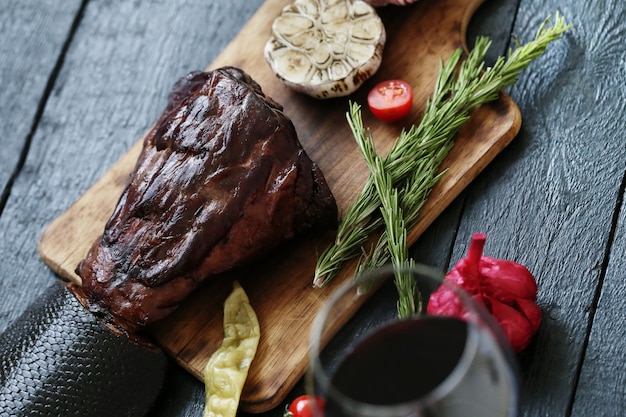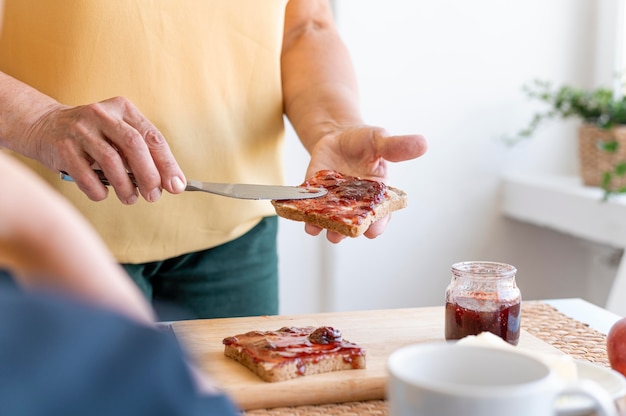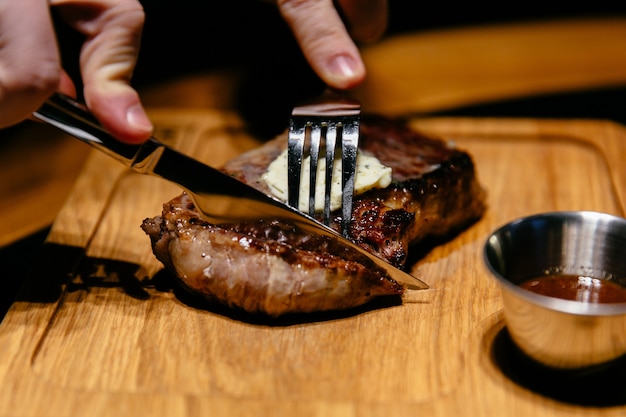Ah, ribs. The mere mention of those tender, succulent morsels sends a shiver of delicious anticipation down my spine. You see, I’m not just some casual rib enthusiast. I'm talking years of experience, countless experiments, and more than a few burnt offerings (don't worry, the dog always loved them!). And let me tell you, the key to those melt-in-your-mouth, fall-off-the-bone ribs you dream about? It's all about nailing the temperature.
So, grab a cuppa, settle in, and let me spill the beans on the secrets to perfect rib cooking. We're going to delve into everything from the anatomy of a rib to the nitty-gritty of temperature control. Trust me, you'll be a rib master in no time.
(Part 1) The Rib Anatomy: A Deep Dive

First things first, let's get acquainted with our star ingredient: the rib. Now, there are two main types you'll usually encounter: baby back ribs and spare ribs. Both are delicious, but they've got some key differences.
baby back ribs: The Petite Powerhouse
Baby back ribs, as the name suggests, are a bit more delicate. They're cut from the loin section of the pig, right below the backbone. This makes them smaller, more tender, and a touch leaner than their spare rib counterparts. They're like the dainty, but oh-so-flavorful, cousin of the rib family. Expect a less fatty, more meaty bite with a beautiful, even texture. They tend to be a bit pricier, but trust me, their flavour and tenderness are worth the splurge.
Spare Ribs: The Big, Bold, and Bouncy
Now, spare ribs, these are the big hitters. They hail from the belly of the pig, and let me tell you, they're longer and meatier than their baby back counterparts. Spare ribs have a higher fat content, which makes for a richer flavour and a slightly chewier texture. This is the rib for folks who want a substantial, meaty feast, one that'll leave you feeling truly satisfied.
(Part 2) The Perfect rib temperature: A Breakdown

Okay, now we're getting to the heart of the matter: the temperature. Ribs crave a long, slow cook. Think of it as a spa day for the meat, where collagen breaks down and the meat becomes ridiculously tender. But what exactly are the temperatures we need to aim for?
The Magic Number: 225°F (107°C)
My go-to temperature for ribs is a steady 225°F (107°C). This low and slow heat allows the meat to cook evenly, and that collagen? It breaks down like a dream. But hold your horses, we're not talking about the temperature of your oven here. We're talking about the internal temperature of the ribs themselves.
Checking for Doneness: A meat thermometer's Best Friend
So, how do we know if our ribs are cooked to perfection? A trusty meat thermometer is your absolute best friend in this situation. We're aiming for an internal temperature of 190°F (88°C). That's when you know those ribs are ready for their close-up. But it's not just about the final temperature. The whole cooking process plays a crucial role in achieving that perfect tenderness.
(Part 3) The Cooking Process: Slow and Steady Wins the Race

Now, let's talk about the actual cooking process. It's all about slow and steady, allowing the heat to penetrate the meat and break down that collagen, creating the ultimate melt-in-your-mouth experience. Here's my tried-and-true method for achieving those succulent, tender ribs:
The Pre-Cook Prep: A Little TLC for the Ribs
First things first, let's give our ribs a little TLC. I love a good dry rub. A blend of smoked paprika, brown sugar, garlic powder, onion powder, salt, and pepper creates a beautiful, flavorful crust. Get in there and really massage that rub into the ribs, every nook and cranny. This step adds a depth of flavor and helps to create a crispy, delicious bark on the ribs.
The Low and Slow Method: Patience is Key
Next, I cook my ribs in my trusty smoker at 225°F (107°C). Now, you can absolutely use an oven for this step, but a smoker adds that incredible smoky flavor we all crave. I usually cook my ribs for about 4-5 hours, or until they reach that coveted 190°F (88°C) internal temperature. This is where patience comes in, my friend.
The Wrapping Technique: A Secret to Super Tenderness
Here's a little secret: wrapping your ribs in foil for the last hour or two of cooking can create those extra-tender, melt-in-your-mouth ribs we all dream about. The steam trapped inside helps to break down even more collagen. It's like giving your ribs a little steam bath for maximum tenderness. Just make sure to take the foil off for the final 30 minutes of cooking to allow that beautiful bark to crisp up.
(Part 4) Rib Cooking Temperatures: A Table for Reference
I know, I know, numbers can be a bit overwhelming. But fear not! I've put together a handy table to help you keep track of all the important temperatures:
| Rib Type | Ideal Cooking Temperature (°F) | Internal Temperature for Doneness (°F) | Approximate cooking time (hours) |
|---|---|---|---|
| Baby Back Ribs | 225°F (107°C) | 190°F (88°C) | 4-5 hours |
| Spare Ribs | 225°F (107°C) | 190°F (88°C) | 5-6 hours |
(Part 5) Essential Tools for perfect ribs
Alright, now that we've tackled the basics, let's talk about the tools of the trade. Here's what you'll need to achieve rib-cooking greatness:
- Meat Thermometer: This is your absolute best friend for ensuring your ribs are cooked to perfection. Invest in a good quality thermometer that reads accurately and quickly. It's the only way to truly know when those ribs are done.
- Smoker: While not strictly necessary, a smoker is the ultimate tool for infusing your ribs with smoky goodness. It's a worthwhile investment if you're serious about achieving those authentic smoky flavours.
- Oven: If you don't have a smoker, a good quality oven can certainly do the job. Just make sure it can hold a steady low temperature.
- Heavy Duty Foil: This is essential for wrapping your ribs towards the end of the cooking process, creating extra tenderness and moisture. You'll thank me later for this step.
- Meat Injector: While not strictly necessary, a meat injector can help to infuse your ribs with additional flavour, especially if you're using a marinade. It's a great way to add a little extra oomph to your ribs.
(Part 6) Rib Cooking Variations: Beyond the Basics
Now, let's talk about getting creative. While the basic low and slow method works wonders, there's a whole world of rib cooking variations to explore. Let's dive into some of my favourite techniques:
The Dry Rub Method: A Classic for a Reason
This is my go-to method for most of my rib cooking. A dry rub adds a beautiful crust to the ribs and infuses them with flavour. You can use a store-bought rub or create your own blend. Just be sure to include ingredients like smoked paprika, brown sugar, garlic powder, and onion powder for a truly flavourful rub. Experiment with different spices and herbs to find your perfect combination.
The Marinade Method: For Deep, Rich Flavour
Marinating your ribs before cooking is a great way to infuse them with a deeper, more intense flavour. I like to use a marinade made with soy sauce, Worcestershire sauce, brown sugar, garlic, and black pepper. Let the ribs soak in the marinade for at least 4 hours, but overnight is best for maximum flavour absorption. This will give the flavours a chance to really penetrate the meat, resulting in a truly delicious rib experience.
The Mop Sauce Method: Adding Moisture and Flavour
Mop sauce is a great way to add moisture and additional flavour to your ribs during cooking. You can use a store-bought mop sauce or create your own. A simple mop sauce can be made with apple cider vinegar, brown sugar, and a touch of Worcestershire sauce. Just brush the mop sauce onto the ribs every hour or so during cooking. The result? Tender, juicy ribs with a beautiful glaze.
(Part 7) FAQs: Rib Cooking Questions Answered
Now, let's address some of the burning questions you might have about rib cooking. I've got you covered!
1. What is the best way to tell if ribs are done?
The best way to tell if ribs are done is to use a meat thermometer. You want the internal temperature to reach 190°F (88°C). The ribs should also feel very tender when you gently pull on them. If they fall apart easily, you know they're done! You can also give them the "bend test" - if the bone bends easily, you're in good shape.
2. Can you overcook ribs?
Yes, you certainly can overcook ribs. If you cook them too long, they can become dry and tough. The best way to avoid overcooking is to use a meat thermometer and cook them until they reach the desired internal temperature. Pay attention to the texture as well, and don't be afraid to pull them off the heat early if they feel a bit dry.
3. How long should ribs rest after cooking?
It's important to let ribs rest for about 10 minutes after cooking. This allows the juices to redistribute throughout the meat, resulting in more tender and juicy ribs. Think of it as a little recovery time for those hardworking ribs.
4. What are the best side dishes for ribs?
Ribs pair well with a variety of side dishes, but some of my favourites include coleslaw, baked beans, potato salad, mac and cheese, and corn on the cob. These classics complement the rich flavours of the ribs perfectly, creating a truly satisfying meal.
5. Can you freeze ribs?
Yes, you can freeze ribs. Just make sure to wrap them tightly in plastic wrap and foil before freezing. Frozen ribs can be stored for up to 3 months. This is great for meal prepping or if you've got a surplus of ribs. Just make sure to thaw them in the refrigerator overnight before cooking.
(Part 8) Rib Cooking: A Journey of Flavour and Satisfaction
Right, well, there you have it. My secrets to cooking the perfect ribs. It's not rocket science, but it does take a bit of patience and practice. Don't be afraid to experiment with different rubs, marinades, and cooking techniques to find your perfect rib recipe. And remember, the most important thing is to have fun with it. Happy rib cooking!
Everyone is watching

Corn on the Cob: The Ultimate Guide to Perfectly Cooked Ears
Healthy MealsAh, corn on the cob. Just the name evokes images of sunny days, barbecues, and that sweet, juicy flavour that ...

Scallops: The Ultimate Guide to Perfect Cooking
Healthy MealsAh, scallops. Those delicate, sweet, and utterly delicious morsels of the sea. They hold a special place in my...

Spaghetti Squash: The Ultimate Guide to Cooking and Serving
Healthy MealsRemember that time you saw spaghetti squash at the supermarket, looking all bumpy and strange, and thought, "W...

Salmon Cooking Times: Perfect Guide for Every Recipe
Healthy MealsLet me tell you, cooking salmon is an art form. It's all about getting that perfect balance: juicy and tender,...

Ham Cooking Time: How Long to Bake, Smoke, or Boil a Delicious Ham
Healthy MealsAh, ham. It's a classic, isn't it? A real crowd-pleaser, especially around holidays. And when done right, it'...
